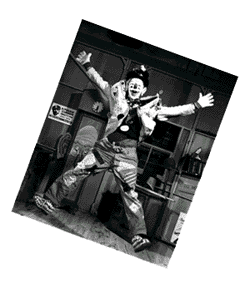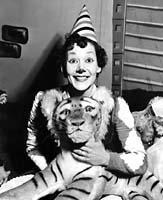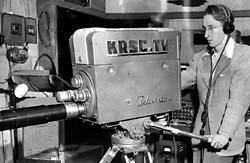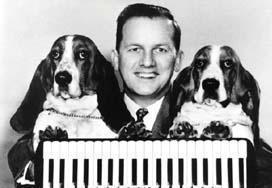 J. P. Patches, at left. Photo Credit: Photographic Productions
J. P. Patches, at left. Photo Credit: Photographic Productions
By Sharon Boswell
and Lorraine McConaghy
Special to The Times
Nearly 13,000 cheering spectators filled Seattle's
Memorial Field on a late November afternoon in 1948 as West Seattle,
the city co-champions, took on the Wenatchee Panthers in the annual
Thanksgiving Day high-school football classic. The cross-state rivals
battled to a thrilling 6-6 tie.
Yet perhaps even more thrilling for thousands of others who jammed
appliance stores, clubs and taverns around town was to watch the
game on television. It was the first commercial program ever broadcast
in Seattle, and by all accounts a memorable event.
"Television is here," announced The Seattle Times in a special supplement,
explaining the technology behind this "magical" medium and advising viewers
on how to use test patterns to tune their sets. But at this early stage,
the advent of TV seemed primarily a marketing opportunity. "Television places
a whole new world of home entertainment at your very feet," teased advertisers,
wooing buyers with Philco consolettes for $359.50 or Admiral's Triple Thrill
model that included a radio and phonograph for just $200 more.
Seattleites had to be sold on the idea that this newcomer could really compete
with other media, particularly radio, which had entertained and informed for
decades. Yet radio, "the voice of the people" had also taken time to become
widely accepted.
The city once proudly claimed to be home to pioneer radio broadcasting:
A young inventor, William Dubilier, had transmitted voice messages between
Seattle and Tacoma on his "wireless telephone" as early as 1910. But
it was not until 1922 that the region's first radio station, KJR, received
a license and the industry really took off. Soon colleges, churches,
and even department stores installed transmitters and began broadcasting.
|
'Wunda Wunda'
Starring: Ruth Prins Station: KING-TV Years on air: 1953-1972 Photo Credit: Forde Photographers. |

|
Bigger, better-bankrolled operations came to dominate the airwaves.
Most notable was KOMO, owned by Seattle's Fisher family, whose interests
also included flour mills. KIRO soon followed. Started by a rival milling
company, the station was taken over and expanded by Seattle businessman and
politico Saul Haas.
By the 1930s, radio's golden age had dawned. In Seattle, each station
cultivated its individual personality and its own stable of radio talent.
Throughout this era, experimentation also continued on new broadcasting
technology. In June 1929, Seattle's first television pictures --
mostly symbols, letters and numbers -- were beamed across the airwaves,
and a few with vision saw the potential. By 1948, when KRSC, a small
Seattle radio station, obtained a television broadcasting license,
equipment was available to show Thanksgiving Day football live.
 A technician at KRSC-TV, Seattle's first television station, checks
the camera before heading to a sporting event in 1949. Photo Credit: Seattle Times.
A technician at KRSC-TV, Seattle's first television station, checks
the camera before heading to a sporting event in 1949. Photo Credit: Seattle Times.
KRSC-TV WAS ONLY THE 15TH TELEVISION STATION IN THE NATION, but
its local radio rivals recognized they had to jump quickly into the fray.
The Federal Communications Commission initially stymied their efforts, hoping
to stop the mad scramble nationwide by placing a moratorium on new licenses.
In the meantime, Dorothy Bullitt, a broadcasting industry newcomer,
purchased money-short KRSC, changing the call letters to KING and taking
advantage of its brief local TV monopoly to create the region's television giant. In 1952 when licensing resumed, the Fisher stations -- led by O.W. Fisher -- finally broke into the business with KOMO-TV. It took KIRO five more years of legal battles to get a television permit.
Competition for network affiliation was cutthroat as stations vied to air such
hugely popular shows as Milton Berle or "I Love Lucy." Like radio, however,
area television executives soon found it lucrative to broadcast more of their own live shows. Aside from sporting events, with weekly wrestling matches a favorite, local television focused on family fare -- everything from musical variety programs to chatty interviews, cookbook quizzes and helpful homemaker shows.
|
'King's Clubhouse' theme song
Zero dachus, Mucho Crackus
'King's Clubhouse' |
 Photo Credit: Seattle Times. |
Historians Sharon Boswell and Lorraine McConaghy teach at local universities and do research,
writing and oral history. Original newspaper graphics courtesy of the Seattle Public Library.